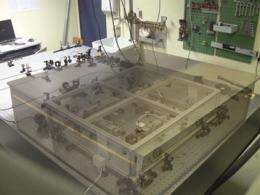When the speed of light depends on its direction

Light does not travel at the same speed in all directions under the effect of an electromagnetic field. Although predicted by theory, this counter-intuitive effect has for the first time been demonstrated experimentally in a gas by a French team from the Laboratoire 'Collisions Agregats Reactivite' at CNRS. The researchers measured with extreme precision, of around one billionth m/s, the difference between the light propagation speeds in one direction and in the opposite direction. These results open the way to more in-depth research aimed at improving the model that describes elementary particle interactions. Published on the 11 May 2011 in the journal Physical Review Letters, they point to novel applications in optics.
In an absolute vacuum, light travels at a constant velocity of 299,792,458 m/s. It seems natural that it should propagate at the same speed in all directions. However, counter-intuitively, there are situations in which this property is not valid, particularly when an electric field and a magnetic field are applied. Such cases were first predicted by theory in the late 1970s and should even be observed in a vacuum. However, these very slight variations are difficult to confirm experimentally.
Technological progress has now made it possible to detect these effects in a gas (in this instance nitrogen). To observe them, researchers from CNRS designed an optical cavity in which the light beams pass through a device comprising magnets and electrodes, which makes it possible to generate intense electric and magnetic fields (the applied magnetic field is 20,000 times greater than that of the Earth). In this way they succeeded in demonstrating experimentally, for the first time, that light does not travel at the same speed in opposing directions in a gas where an electromagnetic field reigns. The measured difference in velocity is around one billionth m/s (i.e. 10-9 m/s, which is equivalent to 10-18 times the speed of light). This infinitesimal difference, predicted by theory, is caused by the magnetic and electric fields.
These results open up several new avenues. Firstly, they could allow measurements of the anisotropy of light propagation to be pushed even further. By increasing the sensitivity of the measuring device, researchers could, one day, observe minute failures of Lorentz invariance, which is a fundamental symmetry expressed as part of the theory of relativity. This would make it possible to test certain theoretical proposals to improve the standard model (a model which today describes all of the interactions between elementary particles). Secondly, such directional anisotropy governed by an electromagnetic field could open up novel applications in optics, such as components whose behavior would differ depending on the direction, with everything being controlled by a magnetic field.
More information: Magnetoelectric directional nonreciprocity in molecular nitrogen gas. B. Pelle, H. Bitard, G. Bailly and C. Robilliard. Physical Review Letters, 11 May 2011. DOI: 10.1103/PhysRevLett.106.193003
Abstract
We report the direct observation of the nonreciprocity of the velocity of light, induced by electric and magnetic fields. This bilinear magneto-electro-optical effect appears in crossed electric and magnetic fields perpendicular to the light wave vector, as a refractive index difference between two counterpropagating directions. Using a high finesse ring cavity, we have measured this magnetoelectric nonreciprocity in molecular nitrogen at ambient temperature and atmospheric pressure; for light polarized parallel to the magnetic field it is 2η∥exp(N2)=(4.7±1)×10-23 m V-1 T-1 for λ=1064 nm, in agreement with the expected order of magnitude. Our measurement opens the way to a deeper insight into light-matter interaction beyond the electric dipole approximation. We were able to measure a nonreciprocity as small as Δn=(5±2)×10-18, which makes its observation in quantum vacuum a conceivable challenge.
Provided by CNRS



















